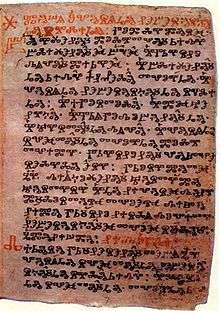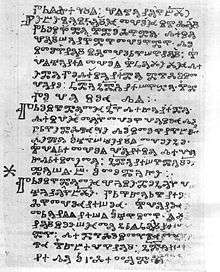Kiev Missal
The Kiev Missal (or Kiev Fragments or Kiev Folios; scholarly abbreviation Ki) is a seven-folio Glagolitic Old Church Slavonic canon manuscript containing parts of the Roman-rite liturgy. It is usually held to be the oldest and the most archaic Old Church Slavonic manuscript,[1] and is dated at no later than the latter half of the 10th century.[2] Seven parchment folios have been preserved in small format (cca 14,5x10,5 cm) of easily portable book to be of use to missionaries on the move.


Discovery and publishing
Kiev Folios have been found in the 19th century in Jerusalem by the Archimandrite Andrej Kapustin (Antonin Kapustin) who donated them the Kiev Theological Academy.[3] After the revolution the folios were transferred to the library of the Ukrainian Academy of Sciences in Kiev where they are being kept today.
Izmail Sreznevsky made the manuscript known to the public, editing the first edition of Kiev Folios in 1874. They have been republished many times since, though not always successfully. Notable editions are by Vatroslav Jagić in 1890 (Glagolitica. 2. Würdigung neuentdeckter Fragmente, Mit 10 Taf., Wien 1890, Denkschrift. Kaiserl. Akad., Bd. 38), by Sievers in 1924 (Die altslavischen Verstexte von Kiew und Freising, Leipzig 1924, Akad. Wiss., phil.-hist. Kl., Bd. 76/2) and by Mohlberg in 1928 (Il messale di Kiew/sec IX./ed il suo prototipo Romano del VI-VII). Special attention to the Kiev folios has been paid by Václav Vondrák in a paper O původu Kijevských listů a Pražských zlomků a o bohemismech v starších církevněslovanských památkách vůbec (Praha, 1904). The newest facsimile edition has been published in 1983 in Kiev to honor the ninth International Congress of Slavists which was held there (V. V. Nimčuk, Kijivs′ki hlaholični lystky, AN USSR). That edition contains extensive overview of the existing bibliography of the Kiev Folios.
Dating and origin
The first page of the first folio was written later than other pages, probably at the transition from 11th to 12th century.[3] Linguistic, paleographic and graphic features indicate South Croatian area as its place of origin.[3] This page contains parts of Paul's epistles (13, 11-14 and 14, 1-4). That part of Kiev Folios and the problems associated with it have been thoroughly analyzed by the Croatian Slavist Marija Pantelić,[4] who finally situates them somewhere in the Dubrovnik area.
The rest of the monument, containing part of the Roman Missal is dated at no later than the second half of the 10th century.[3]
Content
By content it is a Roman Missal, i.e., a book collecting all the text used at the holy mass service. Missal texts are accompanied by instructions on how to perform rites throughout the liturgical year, called rubrics, which is a term originating from Latin word rubrica designating red soil used for painting. The text of the Kiev Missal folios has been for the most part written in black (the text meant to be pronounced), and for the lesser part in red (the instructions for gestures that the priest must perform and other instructions for the ceremony). Since the Kiev Missal has only 13 pages preserved, it's obvious that only a part of the missal has been preserved, from the sacramentary containing crucial and unchangeable parts spoken by the priest.
Linguistic features
The Kiev Folios are generally held by Slavists as the oldest among the OCS canon manuscripts, even though they exhibit several West Slavic features that place them at the beginning of the Czech-Moravian recension of OCS.[5] These are:
- Instead of OCS št, žd we find West Slavic reflexes of Proto-Slavic */tj/ (also from earlier *kt) and */dj/, i.e. instead of pomoštь, prosęšte, priemljǫšte, daždь, tuždimъ, tъžde we find pomocь, prosęce, priemljǫce, dazь, tuzimъ, tъze etc.[5]
- At the place of Proto-Slavic *stj and *skj we would expect a reflex of OCS št, but we find šč: očiščeniě, zaščiti (imperative), zaščititь.
- As an ending of instrumental singular of masculine o-stems we would expect -omь. But instead, -ъmь is used, so instead of expected oplatomь, obrazomь, vъsǫdomь we find oplatъmь, obrazъmь, vъsǫdъmь.
- Genitive of first-person pronoun azъ is mene in OCS. In Kiev Folios we find mne by the elision of weak yer.
As features that connect Kiev Folios to the canonic manuscripts of other Slavic areas (namely Bulgaro-Macedonian), one has to note:
- consistent distinguishing between yers ъ and ь, and only twice ъ is found where ь is expected
- Kiev folios preserve nasal vowels (/ę/ and /ǫ/) and don't mix them
Controversies
Croatian Slavist Josip Hamm stirred a fierce debate in his book Das Glagolitische Missale von Kiew (Wien, 1979). In it, and in his other papers and lectures he maintained the view that the Kiev Folios are a 19th-century fake by Czech patriots in order to prove the antiquity of Czech literary culture. However, in general Slavists do not hold this view.
Notes
- ↑ Lunt (2001:9) "The seven glagolitic folia known as the Kiev Folia (KF) are generally considered as most archaic from both the paleographic and the linguistic points of view..."
- ↑ Damjanović (2003:15)
- 1 2 3 4 Damjanović (2003:16)
- ↑ Pantelić (1985)
- 1 2 Damjanović (2003:17)
References
- Damjanović, Stjepan (2004), Slovo iskona (in Croatian), Zagreb: Matica hrvatska, ISBN 953-150-567-5
- Schenker, Alexander M. (1995), The Dawn of Slavic: An Introduction to Slavic Philology, New Haven: Yale University Press, ISBN 0-300-05846-2
- Pantelić, Marija (September 1985), "On Kiev and Sinai folia" (PDF), Slovo (in Croatian), Old Church Slavonic Institute, 35: 5–56
- Zagiba, Franz (September 1964), "Die historische Umkreis der Kiever Sakramentarfragmente" (PDF), Slovo (in German), Old Church Slavonic Institute, 14: 59–77
- Koschmieder, Erwin (September 1955), "Die vermeintlichen Akzentzeichen der Kiever Blätter" (PDF), Slovo (in German), Old Church Slavonic Institute, 4–5: 5–23
- Nedeljković, Olga (September 1964), "Akcenti ili neume u Kijevskim listićima" (PDF), Slovo (in Croatian), Old Church Slavonic Institute, 14: 25–51
- Damjanović, Stjepan (2003), Staroslavenski jezik (4th revised and extended ed.), Zagreb: Hrvatska sveučilišna naklada, ISBN 953-169-095-2
- Lunt, Horace G. (2001), Old Church Slavonic Grammar (7h revised ed.), New York: Mouton de Gruyter, ISBN 3-11-016284-9
External links
- Kiev Folios, at TITUS project
- Kiev Folios, at MANUSCRIPT project